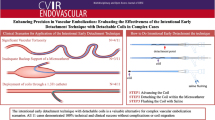Abstract
Introduction
The magnetic navigation system consists of an externally generated magnetic field that is used to control and steer a magnetically tipped microguidewire. The goal of this study was to demonstrate that the use of the magnetic navigation system and its magnetic microguidewire is feasible and safe in all types of neuroendovascular procedures.
Methods
A magnetic navigation system is an interventional workstation that combines a biplanar fluoroscopy system with a computer-controlled magnetic field generator to provide both visualization and control of a magnetically activated endovascular microguidewire. Ten consecutive patients underwent a variety of neuroendovascular procedures using the magnetic guidance system and magnetic microguidewire. All patients presented with a neurovascular disease that was suitable for endovascular treatment. Multiple different devices and embolic agents were used.
Results
Of the ten patients, three were male and seven female. Their mean age was 53.9 years. The predominant neurovascular condition was the presence of intracranial aneurysm (nine patients). One patient had a left mandibular arteriovenous malformation. All treatments were successfully performed on the magnetic navigation system suite. The magnetic navigation system and the magnetic microguidewire allowed safe and accurate endovascular navigation allowing placement of the microcatheters in the desired location. There were no neurological complications or death in our series.
Conclusion
The use of the magnetic navigation system and the magnetic microguidewire in the endovascular treatment of patients with neurovascular diseases is feasible and safe.
Similar content being viewed by others
References
Krings T, Finney J, Niggemann P et al (2006) Magnetic versus manual guidewire manipulation in neuroradiology: in vitro results. Neuroradiology 48:394–401
Schiemann M, Killmann R, Kleen M et al (2004) Vascular guide wire navigation with a magnetic guidance system: experimental results in a phantom. Radiology 232:475–481
Faddis MN, Blume W, Finney J et al (2002) Novel, magnetically guided catheter for endocardial mapping and radiofrequency catheter ablation. Circulation 106:2980–2985
Ernst S, Ouyang F, Linder C et al (2004) Initial experience with remote catheter ablation using a novel magnetic navigation system: magnetic remote catheter ablation. Circulation 109:1472–1475
Faddis MN, Lindsay BD (2003) Magnetic catheter manipulation. Coron Artery Dis 14:25–27
Grady MS, Howard MA 3rd, Dacey RG Jr et al (2000) Experimental study of the magnetic stereotaxis system for catheter manipulation within the brain. J Neurosurg 93:282–288
Tillander H (1951) Magnetic guidance of a catheter with articulated steel tip. Acta Radiol 35:62–64
Tillander H (1956) Selective angiography of the abdominal aorta with a guided catheter. Acta Radiol 45:21–26
Hilal SK, Michelsen WJ, Driller J (1969) POD catheter: a means for small vessel exploration. J Appl Phys 40:1046
Ram W, Meyer H (1991) Heart catheterization in a neonate by interacting magnetic fields: a new and simple method of catheter guidance. Cathet Cardiovasc Diagn 22:317–319
Conflict of interest statement
We declare that we have no conflict of interest.
Author information
Authors and Affiliations
Corresponding author
Rights and permissions
About this article
Cite this article
Dabus, G., Gerstle, R.J., Cross, D.T. et al. Neuroendovascular magnetic navigation: clinical experience in ten patients. Neuroradiology 49, 351–355 (2007). https://doi.org/10.1007/s00234-006-0202-0
Received:
Accepted:
Published:
Issue Date:
DOI: https://doi.org/10.1007/s00234-006-0202-0




